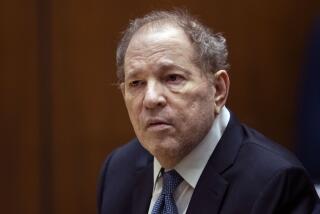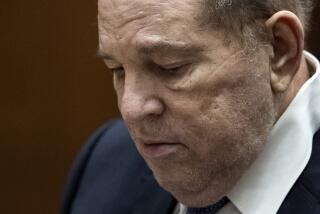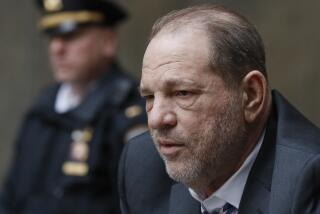Victims’ Rights Apply to Accused Too, Court Rules
SAN FRANCISCO — A state Court of Appeal, in an unusual application of a 1982 anti-crime initiative, has ruled that an accused rapist must be allowed to present evidence that his alleged victim had falsely accused others of rape in the past.
The three-judge panel said Friday that while the “truth in evidence” provision of the Victims’ Bill of Rights was intended to help the prosecution of the guilty, there was “no intent . . . to convict the innocent.”
The far-reaching initiative, listed on the ballot as Proposition 8, eased restrictions on the use of evidence by providing that no “relevant evidence” shall be excluded from criminal proceedings.
Conviction Reversed
In its decision, the appellate court unanimously reversed the conviction of Christopher Adams, accused of rape, assault and oral copulation in an incident in December, 1985, involving a 17-year-old San Francisco girl.
The panel pointed out that the sole issue before the jury had been the credibility of Adams and his accuser, and concluded that it would be a “miscarriage of justice” to allow the conviction to stand.
Had the trial judge allowed testimony from defense witnesses that the girl had twice before made false accusations of rape, it was “reasonably probable” the verdict would have favored the defendant, the court said. Adams, convicted previously for grand theft and breaking into a warehouse, had faced a 14-year prison term for his conviction in the rape case.
The ruling, which may be appealed to the state Supreme Court, struck down a state statute that had barred the use of evidence of a witness’ “character traits” to attack or support his credibility.
The court, in an opinion by Appellate Justice John E. Benson, took note of a 1986 decision by another appeals court saying that Proposition 8 had effectively repealed a separate statute that had barred evidence of a witness’ “truth and honesty” unless they had been first been challenged in court.
Should Aid Defendants
The anti-crime initiative, wrote Benson, “was not designed to liberalize the rules of admissibility only for evidence favorable to the prosecution while retaining restrictions on the admissibility of evidence tending to prove a defendant’s innocence.”
Instead, he said, it was meant “to ensure that those who are actually guilty do not escape convictions through restrictions on the admissibility of relevant evidence.”
Benson’s 18-page opinion was joined by Appellate Justices Allison M. Rouse and Jerome A. Smith.
Adams was accused of following the girl as she got off a bus in the early morning hours on her way home from attending a concert.
Authorities claimed Adams grabbed and choked the girl, threatening to kill her, and then took her to a nearby schoolyard where he twice raped her.
Exchange for Cocaine
Adams claimed that the girl had approached him after they got off the bus and had willingly agreed to sexual intercourse in exchange for cocaine. When he refused to give her the drug, she threatened revenge, he said.
At trial, Adams contended that he had been falsely accused of rape in retaliation by the girl and sought to present the evidence she had previously falsely accused others. But prosecutors objected that such evidence was inadmissible, and it was barred by Superior Court Judge Thomas J. Dandurand from being used to challenge the girl’s credibility.
The appeals court, noting that there were no eyewitnesses to the incident, said that the excluded evidence “could have bolstered (Adams’) credibility” sufficiently to cause the jury to have reasonable doubt about his guilt.
Under such circumstances, the panel said, Adams was entitled to a new trial.
More to Read
Sign up for Essential California
The most important California stories and recommendations in your inbox every morning.
You may occasionally receive promotional content from the Los Angeles Times.










